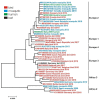Epidemiology of Usutu Virus: The European Scenario
- PMID: 32858963
- PMCID: PMC7560012
- DOI: 10.3390/pathogens9090699
Epidemiology of Usutu Virus: The European Scenario
Abstract
Usutu virus (USUV) is an emerging arbovirus isolated in 1959 (Usutu River, Swaziland). Previously restricted to sub-Saharan Africa, the virus was introduced in Europe in 1996. While the USUV has received little attention in Africa, the virus emergence has prompted numerous studies with robust epidemiological surveillance programs in Europe. The natural transmission cycle of USUV involves mosquitoes (vectors) and birds (amplifying hosts) with humans and other mammals considered incidental ("dead-end") hosts. In Africa, the virus was isolated in mosquitoes, rodents and birds and serologically detected in horses and dogs. In Europe, USUV was detected in bats, whereas antibodies were found in different animal species (horses, dogs, squirrels, wild boar, deer and lizards). While bird mortalities were not reported in Africa, in Europe USUV was shown to be highly pathogenic for several bird species, especially blackbirds (Turdus merula) and great gray owls (Strix nebulosa). Furthermore, neurotropism of USUV for humans was reported for the first time in both immunocompromised and immunocompetent patients. Epizootics and genetic diversity of USUV in different bird species as well as detection of the virus in mosquitoes suggest repeated USUV introductions into Europe with endemization in some countries. The zoonotic potential of USUV has been reported in a growing number of human cases. Clinical cases of neuroinvasive disease and USUV fever, as well as seroconversion in blood donors were reported in Europe since 2009. While most USUV strains detected in humans, birds and mosquitoes belong to European USUV lineages, several reports indicate the presence of African lineages as well. Since spreading trends of USUV are likely to continue, continuous multidisciplinary interventions ("One Health" concept) should be conducted for monitoring and prevention of this emerging arboviral infection.
Keywords: Europe; Usutu virus; epidemiology; “One Health”.
Conflict of interest statement
The authors declare no conflict of interest.
Figures



References
-
- Cadar D., Lühken R., van der Jeugd H., Garigliany M., Ziegler U., Keller M., Lahoreau J., Lachmann J., Becker N., Kik M., et al. Widespread activity of multiple lineages of Usutu virus, Western Europe, 2016. Eurosurveillance. 2016;22:30452. doi: 10.2807/1560-7917.ES.2017.22.4.30452. - DOI - PMC - PubMed
-
- Durand B., Haskouri H., Lowenski S., Vachiery N., Beck C., Lecollinet S. Seroprevalence of West Nile and Usutu viruses in military working horses and dogs, Morocco, 2012: Dog as an alternative WNV sentinel species? Epidemiol. Infect. 2016;144:1857–1864. doi: 10.1017/S095026881600011X. - DOI - PMC - PubMed
-
- Ben Hassine T., De Massis F., Calistri P., Savini G., Bel Haj Mohamed B., Ranen A., Di Gennaro A., Sghaier S., Hammami S. First detection of co-circulation of West Nile and Usutu viruses in equids in the south-west of Tunisia. Transbound. Emerg. Dis. 2014;61:385–389. doi: 10.1111/tbed.12259. - DOI - PubMed
Publication types
Grants and funding
LinkOut - more resources
Full Text Sources

